General Lab Safety Training
Faculty must provide safety training to ALL personnel within 30 days of employment. All training must be documented in the PBEE office. A copy will be sent to EHS. Personnel will find most of the general information on this web page, but specifics such as locations of safety items and lab protocols unique to each lab are the responsibility of the individual faculty supervisor. Faculty are legally responsible even if they have delegated safety training to another employee (e.g., technician, graduate student, or postdoc).
Within 30 days of employment, complete the PBEE Safety Training Exam and provide a hard copy to the administrative assistant in the PBEE office. He/She will send a copy to EHS.
All employees will need to watch quarterly safety videos to stay current on lab safety techniques and procedures. Here is a short video on Lab Techniques and Safety with a Crash Course in Chemistry.
Know where to find and use these emergency items:
fire extinguisherEach lab must have readily available
eyewash station
safety shower
first aid kit
ALL chemical containers MUST be labeled witha chemical inventory list (CIL; available online) which must be updated as chemicals are received or disposed of.
a contingency plan checklist (emergency notification form)
chemical ingredients & concentrationsNFPA/HMIS Hazard labels (available in 301 PS) tell you about the hazards associated with a chemical
date
name/initials of responsible person
required protective gear (goggles, gloves)
(0= low risk, 4 = severe risk)
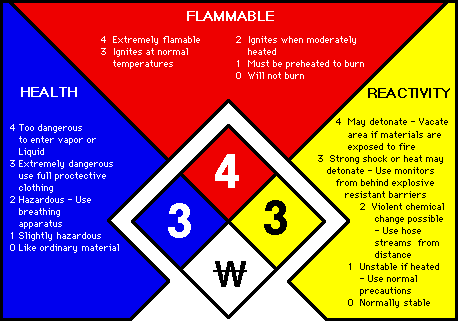
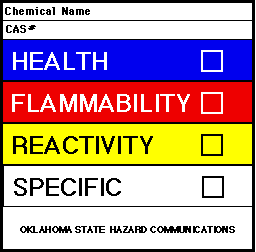
SPECIFIC examples
 |
or OXY = oxidizer (avoid combustibles) |
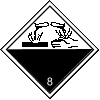 |
or COR = corrosive |
 |
= carcinogen (cancer-causing) | 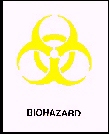 |
= biohazard |
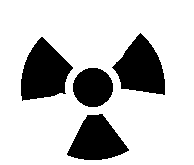 |
= radioactive | W = avoid water ALK = alkali |
|
Store oxidizers (nitrates/-ites, peroxides, chromates, iodates) separately, away from combustibles.
YOU must request an SDS (safety data sheet) from retailer each time you purchase a chemical. SDSs for the PBEE labs in Life Sciences East are stored prominently in LSE 022 where they are ALWAYS accessible. SDSs for PBEE labs in the Henry Bellmon Research Center (HBRC) and Physical Sciences (PS) will be kept in the individual labs.
Searchable Online SDS database
SDS = name(s) of ingredient(s), CAS# (chemical abstract servive) + ...
- physical & fire/explosion data, NFPA #s
- toxicity
- health effects & first aid
- reactivity, incompatibility, polymerization
- storage & disposal procedures
- conditions to avoid (what NOT to do with this chemical)
- spill & leak procedures
- protective equipment
Common "clean" waste acids/bases may go down drain ONLY after neutralizing to pH 6-8 w/ compatible acid/base. Organic solvents, heavy metals, etc. should NEVER be poured down the drain. Store compatible waste solvents, toxics in appropriate small (<4 L), labeled container.
Label full containers w/ orange hazardous chemical surplus tag (obtain from 301 PS).
To remove chemicals, fill out a Request For Chemical Removal form. Give it to the administrative assistant in the main office. He/she will obtain the department head's signature and send it on to EHS.
An employee exposure report must be filed within 24 hours after ANY incident. Keep the original in the lab. Give a copy to the administrative assistant in the PBEE office, who will then mail a copy to EHS.
